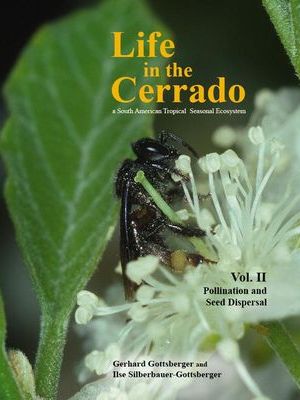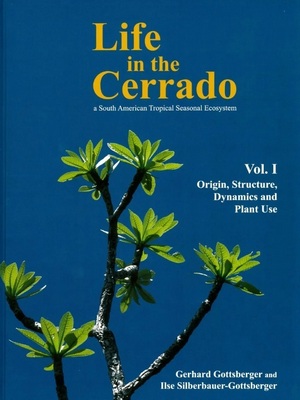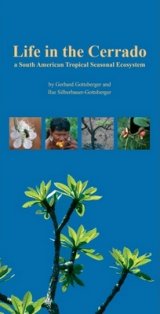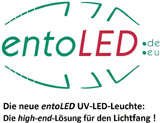Gottsberger & Silberbauer-Gottsberger
Gottsberger & Silberbauer-Gottsberger 2006
Life in the Cerrado - A South American Tropical Seasonal Ecosystem Set Vol. I and Vol. II
A set of both Volumes, Infos see below. Save 10 €.
Gottsberger & Silberbauer-Gottsberger 2006
Life in the Cerrado - A South American Tropical Seasonal Ecosystem Vol. II: Pollination and Seed Dispersal
 383 pages, including numerous color figures, drawings and tables, hardcover, format 22.5 x 29.5 cm.
383 pages, including numerous color figures, drawings and tables, hardcover, format 22.5 x 29.5 cm.
In the second volume, pollination and seed dispersal phenomena are described, and emphasis placed on how these processes, essentially plant-animal interrelationships, are critical to the maintenance and regeneration of this ecosystem.
* Introduction
* Events and Processes Leading to Reproduction and Seed Formation
* Generalist Insect-Pollinated Species Usually Having Bees as Principal Visitors of Day-Active Flowers
* Generalist Flowers Having a Greater Beetle Component
* Generalist Flowers Having an Occasional Beetle Component
* Pollen-Flowers in Dilleniaceae, Clusiaceae, Myrtaceae and Mimosaceae
* Species Pollinated by Small and Medium-Sized Bees
* Choripetalous Open or Partially Constricted Nectar-Flowers
* Choripetalous Open Pollen-Flowers
* Choripetalous Papilionoid Nectar-Flowers
* Sympetalous Actinomorphic or Zygomorphic Nectar-Flowers
* Flowers with Explosive Release of Pollen
* Pollination by Resin-Collecting Bees
* Species with Nectar-Flowers Pollinated by Large Bees
* Choripetalous Actinomorphic or Zygomorphic Flowers
* Choripetalous Papilionoid Flowers
* Sympetalous Flowers
* Floral Ecology of Bee-Pollinated Bignoniaceae
* Superimposed Pollination Systems in Jacaranda
* Oxaea flavescens: Nectar Robber or Pollinator?
* Buzz Pollination in Pollen-Flowers Having Poricidal Anthers
* Pollination of Solanum lycocarpum and Ouratea Flowers
* Multistaminate Large Flowers of Cochlospermum
* The Riddle of Mass-Flowering Miconia Species
* Flower Structures and Pollination in Cassiinae: Variations on a Theme
* Oil-Flowers and Oil-Collecting Bees
* The Native Cerrado Bee Fauna and the Introduced Honeybee
* Scarcity of Fly Pollination
* Cerrado Palms: From General Entomophily with Bees Predominating to Cantharophily
* In the Evening When the Beetles Come: Pollination in Annonaceae and Philodendron
* The Opportunists: Butterflies
* Generalist Night- (and Day)-Active Flowers, with Increasing Tendency Towards Moth (Nocturnal Lepidoptera) Pollination
* Moth Pollination
* Pollination and Evolution in Vochysiaceae
* The Silent Pollinators: Bats
* Hummingbirds and their Flowers
* Wind Pollination
* Pollination and Floral Biology in One Hectare of Cerrado
* Pollination and Floral Biology within Cerrado sensu lato and as Compared to Other Vegetation Types
* Sex Expression and Breeding Systems
* Herbivory and its Links to Reproduction and Regeneration; Parasitic Fungi and Myxomycetes
* Ants and Termites and their Influence on Plants and Vegetation
* Animals and their Role as Seed Dispersal Agents
* The Study of Dispersal in Cerrado Vegetation
* Field Work and Methods Used During Studies of Dispersal Phenomena in Two Plots of Cerrado sensu stricto and Cerradão in Botucatu
* Principal Dispersal Modes, their Relation to Height Classes and Examples of Dispersal Phenomena in the Cerrado sensu stricto Hectare, Botucatu
* Dispersal and Trypanocarpy in Grasses
* Relationship Between the Morphology of Dispersal Units and their Dispersal
* Observations on Hygroscopic Movements of Awns
* Modes of Zoochory in the Cerrado sensu stricto Hectare and their Relationship to Height Classes
* Dispersal Modes Related to Fruiting Time in the Cerrado sensu stricto Hectare
* Dispersal Modes in the Cerradão Hectare as Compared with the Cerrado sensu stricto Hectare in Botucatu
* Distribution Pattern in Relation to Dispersal Mode
* References
* General Index
* Index of Plant Names
* Index of Animal Names
Gottsberger & Silberbauer-Gottsberger 2006
Life in the Cerrado - A South American Tropical Seasonal Ecosystem Vol. I: Origin, Structure, Dynamics and Plant Use
 277 pages, including numerous color figures, drawings and tables, hardcover, format 22.5 x 29.5 cm
277 pages, including numerous color figures, drawings and tables, hardcover, format 22.5 x 29.5 cm
The first volume examines in detail the vegetation, its structure, dynamics and presumed origin. Emphasis is on the adaptational features of plants in relation to their physical environment, in particular climate, soil conditions and fire. Further, the utility of cerrado plants to humans is discussed, the influence of man upon this ecosystem, and some of the problems associated with conservation politics.
* Preface
* Map with Major Localities Cited in the Text
* Introduction
* Definition of Cerrado and Distinction From Other Vegetation Types
* Geographical Location and Extension of the Cerrado Biome
* Geology, Geomorphology, Paleoclimate, Paleoecological Changes and Origin of Cerrado
* Climate
* Soil Properties and Soil, Vegetation and Plant Relationships
* Vegetation Physiognomy
* Other Vegetation Types in the Cerrado Region and Transitional Forms
* The Origin of the Cerrado Flora
* Floristic Diversity and Community Structure
* Plant Physiognomy, Life Forms, Growth Forms and Underground Organs
* Tree Age, Growth Rate and Growth Rhythm
* Water Balance, Nutrient Availability, and Xeromorphic and Scleromorphic Features of Cerrado Plants
* Fire and its Influence on Plants and Vegetation
* Frost and its Effects on Species Distribution in the Southern Cerrado Region
* Seasonality and Vegetation Rhythm
* Seed Germination, Seedling Establishment and Cerrado Regeneration Capacity
* Utility of Cerrado Plants and their Economic Potential
* Transformation of Cerrado into Cropland and Pasture, Environmental Consequences and Influence on Soil Dynamics
* Amerindians and Cerrado
* Importance and Future of Cerrado
* References
* General Index
* Index of Plant Names
Gottsberger & Silberbauer-Gottsberger 2006
Life in the Cerrado - International reviews
This authoritative monograph on one of the most remarkable ecosystems of the Neotropics is based on more than 35 years of field work and research by the two authors. It gives not only a survey of the main results of their own multidisciplinary studies, but offers an up-to-date and competent synthesis of the relevant and voluminous literature, often not easily accessible and partly written in Portuguese. The text is well organized and very clearly written, copiously illustrated by many excellent colour photographs and drawings, and supported by numerous schemata and tables. The two volumes on the cerrado ecosystem by Gerhard Gottsberger and Ilse Silberbauer-Gottsberger are a major contribution to our understanding of the biological problems of South America and a must for all interested in this field. Beyond that these volumes are an important step forward in current efforts to better evaluate the links between species diversity, ecological interdependences and evolutionary aspects in the different biomes of our biosphere. (Friedrich Ehrendorfer, Institute of Botany, University of Vienna)
When one opens the two volumes on the Brazilian cerrado first one is immediately overwhelmed by the esthetical pleasure - the sensual impressions - given by the richness of colour photographs most of them master pieces and fine drawings of plants. In the first volume the photographs are more of landscapes and whole plants in the second volume there is a wealth of excellent close ups of flowers and pollinators. The text then provides ample satisfaction for the depth of thought with maps, schemes and graphics and extensive tabulation of informative facts, quantitative data and functional analyses. The two authors have worked together in the cerrados for 35 years and for 12 of these years (1969 1981) very intensively when they had a square one hectare plot of cerrado at Botucatu, Sao Paulo, for particularly detailed and continuous studies (Ulrich Luettge, Institut für Botanik, Technische Universität Darmstadt)
A truly superb and definitive work on cerrado! Multitudinous platitudes would be inadequate to do justice to this incredible work, which is so beautifully executed and so thoroughly done that it instantly becomes a landmark work. The two large-format volumes treat cerrado, a seasonally dry woody vegetation type unique to Central Brazil. This bargain-priced grand synthesis stems from a combined 80 years of study by this husband-wife team. Few other vegetation types in the world are so thoroughly treated, and certainly none is so beautifully and multifariously presented. The very detailed contents listing in the heading essentially provides the best review of this definitive work. This great and grand work belongs on the shelf of not only every biology library but also every holistically minded ecologist. It is an impassioned plea for the conservation of cerrado, should also serve as a compelling inspiration for persevering in long-term research and for synthesizing it. Further praise would be superfluous. (Rudlof Schmid, University of California, Berkeley, USA, from review in: Taxon 56, May 2007)
More than a hundred years after the study of Warming, two other European naturalists are offering a gift to tropical biologists and everyone that loves nature, another scientific masterpiece with the cerrados, the Brazilian tropical savanna, as a focus. Life in the Cerrado shows that natural history is still alive, more vigorous than ever. The first volume, with 21 chapters, opens with an extremely interesting preface that describes the pathways followed by the authors during their studies in Brazil, and additionally introducing their main contributors, also important names to the tropical. The second volume, with 36 chapters, and more related to the main interest of the authors, pollination biology and seed dispersal, is a text absolutely indispensable to anyone who is interested in the study of all aspects linked to tropical plant reproduction. The authors describe thoroughly the pollination systems, vectors and their syndromes, seed formation and dispersal, with a clear evolutionary view in how each aspect has developed in cerrados. Furthermore, it is an extremely important comparative source of information for those who work with pollination biology in other tropical vegetations and to researchers interested in coevolutionary aspects of biodiversity. The most representative and particular cases of special forms of pollination in cerrados are detailed. This second volume is, if possible, even more effectively illustrated than the first one. The tables and figures maintain a masterly quality and clarity in presentation. There are many tables summarizing the results of important papers already published, showing the exact relation between plant species, floral rewards and visitors. The richness of color photos and hand drawings by the authors and by other researches are captivating. The bibliographic review is complete; all important papers and books in animal-plant interactions published on the Brazilian tropical savanna are properly cited. To close this short review, a small consideration about the title. Perhaps Two Lives in Cerrado could represent better the impressive amount of dedication, effort, and real love we feel in each page of these books. Reading them, ones feel like a child learning again the first steps of how to be a real naturalist. (Kleber Del Claro, Tropinet Vol. 19 (1) pg. 12)



